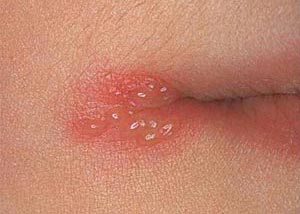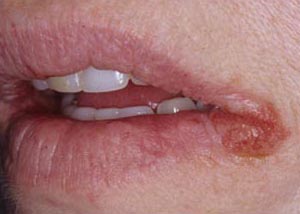Similar Mouth Illnesses to Angular Cheilitis
Not surprisingly, angular cheilitis seems similar to many other mouth illnesses, which leads people to improperly diagnose themselves and use the wrong treatments. This page will go over all the mouth illnesses that people frequently confuse for angular cheilitis.Fever Blisters / Cold Sore (Herpes) vs Angular Cheilitis
Cold sores are caused by the HSV-1 (Herpes Simplex Virus) and on average heal on their own within 2-3 weeks. They symptoms start as a tingling/itchy sensation on or around the lips that will turn into a red area forming one or many small blisters. Eventually these small blisters will from a large red blister which will swell until it bursts creating a weeping ulcer. A scab will soon form and gradually get smaller as the cold sore heals until it is completely gone after 14-20 days.
- Disappears on its own within 2-3 weeks
- Usually appears on your lips
- Starts as itchy/tingling area that turns into one or more small blisters
- Eventually a large blister will form until it starts to weep at which point it scabs over and heals.

- Lasts longer than 2-3 weeks
- Only appears in one or both corners of your mouth
- Starts as dry flaky skin that turns into a red welt
- Gradually gets worse and your lips corners may start to split leaving open wounds

HIV vs Angular Cheilitis
Many people who read about angular cheilitis come across sites that say it is a common symptom of HIV. However, just because you have angular cheilitis does not indicate that you have HIV.
The reason websites claim angular cheilitis is a symptom of HIV is because HIV severely weakens your immune system which makes it easier for your body to get angular cheilitis more frequently. Normally our immune system fights off the bacteria/fungus that causes angular cheilitis before we notice it, however if we are ill, stressed, have had recent mouth trauma, or have had lack of rest it negatively effects our immune system which can cause angular cheilitis to form.
Mouth Ulcer vs Angular Cheilitis
Mouth ulcers are most common in 16-25 year old and rarely occur in people over 55. They are generally an open sore in the mouth that penetrates the mucus membrane within the mouth. They are most common on the inside of lips, on the inside of cheeks, beneath the tongue, and on the gums.
 View pictures of people who have angular cheilitis so you can see if it resembles what you have.
View pictures of people who have angular cheilitis so you can see if it resembles what you have. « Go to The Previous Page
